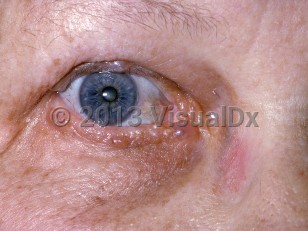Apocrine hidrocystoma - External and Internal Eye
Alerts and Notices
Important News & Links
Synopsis

Apocrine hidrocystomas, also known as sudoriferous cysts or Moll gland cysts, present as translucent or semitransparent, round, skin-colored or bluish masses containing a watery fluid. They most commonly occur along the eyelid margin, but may less commonly occur in the axillae or on the areolae, external ear, periumbilical or anogenital region, and rarely on the scalp and chest. They may be solitary or, less frequently, multiple. The cause is unknown, but they are thought to be due to blockage of the gland. They typically occur in patients over 60 years of age. Both sexes are equally affected.
The lesions are benign and usually asymptomatic. When multiple lesions are present, they may occur in association with Schöpf-Schulz-Passarge syndrome, an autosomal recessive syndrome characterized by multiple eyelid apocrine hidrocystomas, palmoplantar hyperkeratosis, hypodontia, and hypotrichosis.
Related topic: Eccrine hidrocystoma
The lesions are benign and usually asymptomatic. When multiple lesions are present, they may occur in association with Schöpf-Schulz-Passarge syndrome, an autosomal recessive syndrome characterized by multiple eyelid apocrine hidrocystomas, palmoplantar hyperkeratosis, hypodontia, and hypotrichosis.
Related topic: Eccrine hidrocystoma
Codes
ICD10CM:
D23.10 – Other benign neoplasm of skin of unspecified eyelid, including canthus
SNOMEDCT:
254725004 – Apocrine cystadenoma
D23.10 – Other benign neoplasm of skin of unspecified eyelid, including canthus
SNOMEDCT:
254725004 – Apocrine cystadenoma
Look For
Subscription Required
Diagnostic Pearls
Subscription Required
Differential Diagnosis & Pitfalls

To perform a comparison, select diagnoses from the classic differential
Subscription Required
Best Tests
Subscription Required
Management Pearls
Subscription Required
Therapy
Subscription Required
References
Subscription Required
Last Updated:04/06/2022
 Patient Information for Apocrine hidrocystoma - External and Internal Eye
Patient Information for Apocrine hidrocystoma - External and Internal Eye
Premium Feature
VisualDx Patient Handouts
Available in the Elite package
- Improve treatment compliance
- Reduce after-hours questions
- Increase patient engagement and satisfaction
- Written in clear, easy-to-understand language. No confusing jargon.
- Available in English and Spanish
- Print out or email directly to your patient
Upgrade Today


